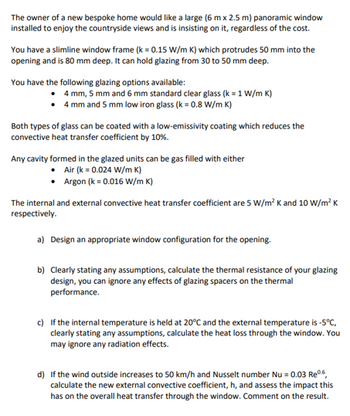
Elements Of Electromagnetics
7th Edition
ISBN: 9780190698614
Author: Sadiku, Matthew N. O.
Publisher: Oxford University Press
expand_more
expand_more
format_list_bulleted
Question
can i get help with this question all parts

Transcribed Image Text:The owner of a new bespoke home would like a large (6 mx 2.5 m) panoramic window
installed to enjoy the countryside views and is insisting on it, regardless of the cost.
You have a slimline window frame (k = 0.15 W/m K) which protrudes 50 mm into the
opening and is 80 mm deep. It can hold glazing from 30 to 50 mm deep.
You have the following glazing options available:
4 mm, 5 mm and 6 mm standard clear glass (k = 1 W/m K)
4 mm and 5 mm low iron glass (k = 0.8 W/m K)
Both types of glass can be coated with a low-emissivity coating which reduces the
convective heat transfer coefficient by 10%.
Any cavity formed in the glazed units can be gas filled with either
Air (k = 0.024 W/m K)
Argon (k = 0.016 W/m K)
The internal and external convective heat transfer coefficient are 5 W/m² K and 10 W/m² K
respectively.
a) Design an appropriate window configuration for the opening.
b) Clearly stating any assumptions, calculate the thermal resistance of your glazing
design, you can ignore any effects of glazing spacers on the thermal
performance.
c) If the internal temperature is held at 20°C and the external temperature is -5°C,
clearly stating any assumptions, calculate the heat loss through the window. You
may ignore any radiation effects.
d) If the wind outside increases to 50 km/h and Nusselt number Nu = 0.03 Reº.6,
calculate the new external convective coefficient, h, and assess the impact this
has on the overall heat transfer through the window. Comment on the result.
Expert Solution
This question has been solved!
Explore an expertly crafted, step-by-step solution for a thorough understanding of key concepts.
Step by stepSolved in 4 steps with 5 images

Knowledge Booster
Learn more about
Need a deep-dive on the concept behind this application? Look no further. Learn more about this topic, mechanical-engineering and related others by exploring similar questions and additional content below.Similar questions
- It a lever has a mechanical advantage of 3, what does that mean? A- The work that the lever does is decreased by a factor of three. B- The lever applies three times more force than you hand can apply. C- Your hand can apply three times more force than the lever can apply.arrow_forwardcan you please resend the answers it says math error and i cant see the whole answerarrow_forwardThe horizontal component of Force F1 (unit is in N), H1= The vertical component of Force F1 (unit is in N), V1 = The horizontal component of Force F2 (unit is in N), H2= The vertical component of Force F2 (unit is in N), V2 = The horizontal component of Force F3 (unit is in N), H3= The vertical component of Force F3 (unit is in N), V3 = The vertical component of Force F4 (unit is in N), V4 = The horizontal component of Force F5 (unit is in N), H5= The vertical component of Force F5 (unit is in N), V5 = The horizontal component of Force F6 (unit is in N), H6= The vertical component of Force F6 (unit is in N), V6 = The sum of horizontal force component for the given system (unit is in N),begin inline style sum for H of end style = The sum of vertical force component for the given system (unit is in N),begin inline style sum for V of end style = The resultant of the given force system is (unit in N), R = The direction of Resultant Force is = Short Answer questionarrow_forward
arrow_back_ios
arrow_forward_ios
Recommended textbooks for you
 Elements Of ElectromagneticsMechanical EngineeringISBN:9780190698614Author:Sadiku, Matthew N. O.Publisher:Oxford University Press
Elements Of ElectromagneticsMechanical EngineeringISBN:9780190698614Author:Sadiku, Matthew N. O.Publisher:Oxford University Press Mechanics of Materials (10th Edition)Mechanical EngineeringISBN:9780134319650Author:Russell C. HibbelerPublisher:PEARSON
Mechanics of Materials (10th Edition)Mechanical EngineeringISBN:9780134319650Author:Russell C. HibbelerPublisher:PEARSON Thermodynamics: An Engineering ApproachMechanical EngineeringISBN:9781259822674Author:Yunus A. Cengel Dr., Michael A. BolesPublisher:McGraw-Hill Education
Thermodynamics: An Engineering ApproachMechanical EngineeringISBN:9781259822674Author:Yunus A. Cengel Dr., Michael A. BolesPublisher:McGraw-Hill Education Control Systems EngineeringMechanical EngineeringISBN:9781118170519Author:Norman S. NisePublisher:WILEY
Control Systems EngineeringMechanical EngineeringISBN:9781118170519Author:Norman S. NisePublisher:WILEY Mechanics of Materials (MindTap Course List)Mechanical EngineeringISBN:9781337093347Author:Barry J. Goodno, James M. GerePublisher:Cengage Learning
Mechanics of Materials (MindTap Course List)Mechanical EngineeringISBN:9781337093347Author:Barry J. Goodno, James M. GerePublisher:Cengage Learning Engineering Mechanics: StaticsMechanical EngineeringISBN:9781118807330Author:James L. Meriam, L. G. Kraige, J. N. BoltonPublisher:WILEY
Engineering Mechanics: StaticsMechanical EngineeringISBN:9781118807330Author:James L. Meriam, L. G. Kraige, J. N. BoltonPublisher:WILEY

Elements Of Electromagnetics
Mechanical Engineering
ISBN:9780190698614
Author:Sadiku, Matthew N. O.
Publisher:Oxford University Press

Mechanics of Materials (10th Edition)
Mechanical Engineering
ISBN:9780134319650
Author:Russell C. Hibbeler
Publisher:PEARSON

Thermodynamics: An Engineering Approach
Mechanical Engineering
ISBN:9781259822674
Author:Yunus A. Cengel Dr., Michael A. Boles
Publisher:McGraw-Hill Education

Control Systems Engineering
Mechanical Engineering
ISBN:9781118170519
Author:Norman S. Nise
Publisher:WILEY

Mechanics of Materials (MindTap Course List)
Mechanical Engineering
ISBN:9781337093347
Author:Barry J. Goodno, James M. Gere
Publisher:Cengage Learning

Engineering Mechanics: Statics
Mechanical Engineering
ISBN:9781118807330
Author:James L. Meriam, L. G. Kraige, J. N. Bolton
Publisher:WILEY